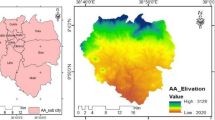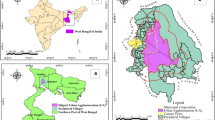Abstract
For the past 60 years, Istanbul has been experiencing an accelerated urban expansion. This urban expansion is leading to the replacement of natural surfaces by various artificial materials. This situation has a critical impact on the environment due to the alteration of heat energy balance. In this study, the effect upon the urban heat island (UHI) of Istanbul was analyzed using 2009 dated Landsat 5 Thematic Mapper (TM) data. An Index Based Built-up Index (IBI) was used to derive artificial surfaces in the study area. To produce the IBI index, Soil-Adjusted Vegetation Index, Normalized Difference Built-up Index, and Modified Normalized Difference Water Index were calculated. Land surface temperature (LST) distribution was derived from Landsat 5 TM images using a mono-window algorithm. In addition, 24 transects were selected, and different regression models were applied to explore the correlation between LST and IBI index. The results show that artificial surfaces have a positive exponential relationship with LST rather than a simple linear one. An ecological evaluation index of the region was calculated to explore the impact of both the vegetated land and the artificial surfaces on the UHI. Therefore, the quantitative relationship of urban components (artificial surfaces, vegetation, and water) and LST was examined using multivariate statistical analysis, and the correlation coefficient was obtained as 0.829. This suggested that the areas with a high rate of urbanization will accelerate the rise of LST and UHI in Istanbul.








Similar content being viewed by others
References
Ayazli, I. E. (2011). Simulation model of urban sprawl driven by transportation networks: 3rd Bosphorus bridge example. Ph.D. Thesis, Istanbul: Yildiz Technical University.
Balik Sanli, F., Bektas Balcik, F., & Goksel, C. (2008). Defining temporal spatial patterns of mega city Istanbul to see the impacts of increasing population. Environmental Monitoring Assessment, 146, 267–275.
Basar, U. G. (2008). Temporal analysis of heat islands in Istanbul using remote sensing data Master of Science Thesis. Istanbul: Istanbul Technical University (in Turkish).
Bektas Balcik, F. (2010). Map** and monitoring wetlands environment by analysis of different satellite images and field spectroscopy. Ph.D. Thesis, Istanbul: Istanbul Technical University Graduate School of Science Engineering and Technology.
Bektas, F., & Goksel, C. (2005). Remote sensing and GIS integration for land cover analysis, a case study: Bozcaada Island. Water Science and Technology, 51(11), 239–244.
Carslon, T. N., & Sanchez-Azofeifa, G. A. (1999). Satellite remote sensing of land use changes in and around San Jose, Costa Rica. Remote Sensing of Environment, 70, 247–256.
Chander, G., & Markham, B. (2003). Revised Landsat-5 TM radiometric calibration procedures and post calibration dynamic ranges. IEEE Transactions on Geoscience and Remote Sensing, 41, 2674–2677.
Chavez, P. S., Jr. (1988). An improved dark-object subtraction technique for atmospheric scattering correction of multispectral data. Remote Sensing of Environment, 24, 459–479.
Dousset, B., & Gourmelon, F. (2003). Satellite multi-sensor data analysis of urban surface temperatures and land cover. ISPRS Journal of Photogrammetry and Remote Sensing, 58, 43–54.
Gallo, K. P., & Owen, T. W. (1999). Satellite based adjustments for the urban heat island temperature bias. Journal of Applied Meteorology, 38, 806–813.
Gillespie, A. R., Rokugawa, S., Matsunaga, T., Cothern, J. S., Hook, S. J., & Kahle, A. B. A. (1998). Temperature and emissivity separation algorithm for advanced spaceborne thermal emission and reflection radiometer (ASTER) images. IEEE Transactions on Geoscience and Remote Sensing, 36, 1113–1126.
Goksel, C., Mercan, D. E., Kapdasli, S., Bektas, F., & Seker, D. Z. (2004). Definition of sensitive areas in a lakeshore by using remote sensing and GIS. Fresenius Environmental Bulletin, 13(9), 860–864.
Goksel, C., Musaoglu, N., Gurel, M., Ulugtekin, N., Tanik, A., & Seker, D. Z. (2006). Determination of land-use change in an urbanized district of Istanbul via remote sensing analysis. Fresenius Environmental Bulletin, 15(8a), 798–805.
Grimm, N. B., Grove, J. M., Pickett, S. T., & Redman, C. L. (2000). Integrated approaches to long-term studies of urban ecological systems. Bioscience, 50, 571–584.
Huete, A. R. (1988). A Soil-Adjusted Vegetation Index (SAVI). Remote Sensing of Environment, 25(3), 295–309.
Hung, T., Uchihama, D., Ochi, S., & Yasuoka, Y. (2006). Assessment with satellite data of the urban heat island effects in Asian megacities. International Journal of Applied Earth Observation and Geoinformation, 8, 34–48.
Ji, L., & Peters, A. J. (2004). A spatial regression procedure for evaluating the relationship between AVHRR–NDVI and climate in the northern Great Plains. Remote Sensing of Environment, 25, 297–311.
Jimenez-Munoz, J. C., & Sobrino, J. A. (2003). A generalized single-channel method for retrieving land surface temperature from remote sensing data. Journal of Geophysical Research, 108, 4688–4694.
Kato, S., & Yamaguchi, Y. (2007). Estimation of storage heat flux in an urban area using ASTER data. Remote Sensing of Environment, 110, 1–17.
Kaya, S., Basar, U. G., Karaca, M., & Seker, D. Z. (2012). Assessment of urban heat islands using remotely sensed data. Ekoloji, 84, 107–113.
Landsat 7 Science Data USers Handbook. http://ltpwww.gsfc.nasa.gov/IAS/handbook/handbook_toc.html. Accessed 10 March 2013.
Landsberg, H. E. (1981). The urban climate (pp. 84–89). New York: Academic.
Li, J.-J., Wang, X. R., Wang, X. J., Ma, W. C., & Zhang, H. (2009). Remote sensing evaluation of urban heat island and its spatial pattern of the Shanghai metropolitan area, China. Ecological Complexity, 6, 413–420.
Liang, S. (2004). Quantitative remote sensing of land surfaces. New Jersey: Wiley.
Liu, L., & Zhang, Y. (2011). Urban heat island analysis using the Landsat TM data and ASTER data: A case study in Hong Kong. Remote Sensing, 3, 1535–1552.
Mcpherson, E. G., Nowak, D., Heisler, G., Grimmond, S., South, C., Grant, R., & Rowntree, R. (1977). Quantifying urban forest structure, function, and value: The Chicago urban forest climate project. Urban Ecosystems, 1, 49–61.
Nichol, J., & Wong, M. S. (2005). Modelling urban environmental quality in a tropical city. Landscape and Urban Planning, 73, 49–58.
Nichol, J., Fung, Y. W., Lam, K., & Wong, M. S. (2009). Urban heat island diagnosis using ASTER satellite images and ‘in situ’ air temperature. Atmospheric Research, 94, 276–284.
Owen, T. W., Carlson, T. N., & Gillies, R. R. (1998). An assessment of satellite remotely sensed land cover parameters in quantitatively describing the climatic effect of urbanization. International Journal of Remote Sensing, 19, 1663–1681.
Pongracz, R., Bartholy, J., & Dezso, Z. (2006). Remotely sensed thermal information applied to urban climate analysis. Advances in Space Research, 37, 2191–2196.
Pu, R., Gong, P., Michishita, R., & Sasagawa, T. (2006). Assessment of multiresolution and multi-sensor data for urban surface temperature retrieval. Remote Sensing of Environment, 104, 211–255.
Qin, Z., Zhang, M., Amon, K., & Pedro, B. (2001). Mono-window algorithm for retrieving land surface temperature from Landsat TM 6 data. Acta Geographica Sinica, 56, 456–466.
Rouse, J. W., Haas, R. H., Schell, J. A., & Deering, D. W. (1973). Monitoring vegetation systems in the great plains with ERTS (pp. 309–317). Third ERTS Symposium, NASA 351 I.
Şahin, M., Yildiz, B. Y., Şenkal, O., & Peştemalci, V. (2012). Modelling and remote sensing of land surface temperature in Turkey. Journal of the Indian Society of Remote Sensing, 40(3), 399–409.
Santana, L. M. (2007). Landsat ETM + image applications to extract information for environmental planning in a Colombian city. International Journal of Remote Sensing, 28, 4225–4242.
Simsek, K. C., & Sengezer, B. (2012). The importance of green spaces in minimizing urban heat in the Istanbul metropolitan area. MEGARON, 7(2), 116–128 (In Turkish with English abstract).
Sobrino, J. A., Jimenez-Munoz, J. C., & Paolini, L. (2004). Land surface temperature retrieval from Landsat TM 5. Remote Sensing of Environment, 90, 434–440.
Sobrino, J. A., Li, Z. L., Stoll, M. P., & Becker, F. (1996). Multi-channel and multi-angle algorithms for estimating sea and land surface temperature with ATSR data. International Journal of Remote Sensing, 17, 2089–2114.
Streutker, D. R. (2002). A remote sensing study of the urban heat island of Houston, Texas. International Journal of Remote Sensing, 23, 2595–2608.
Sun, Q., Tan, J., & Xu, Y. (2010). An ERDAS image processing method for retrieving LST and describing urban heat evolution: A case study in the Pearl River Delta Region in South China. Environmental Earth Science, 59, 1047–1055.
Tan, J., Zheng, Y., Tang, X., Guo, C., Li, L., Song, G., Zhen, X., Yuan, D., Kalkstein, A. L., Li, F., & Chen, H. (2010). The urban heat island and its impact on heat waves and human health in Shanghai. International Journal of Biometeorology, 54, 75–84.
Tian, Q., & **angjun, M. (1998). Advances in study on vegetation indices. Advances in Earth Sciences, 13(4), 327–333.
Turkish Statistical Institute. http://www.turkstat.gov.tr. Accessed March 20, 2013.
Van de Griend, A. A., & Owe, M. (2003). On the relationship between thermal emissivity and the normalized difference vegetation index for natural surfaces. International Journal of Remote Sensing, 14, 1119–1131.
Van Thi, T., & Xuan Bao, H. D. (2010). Study of the impact of urban development on surface temperature using remote sensing in Ho Chi Minh City, northern Vietnam. Geographical Research, 48, 86–96.
Voogt, J. A., & Oke, T. R. (2003). Thermal remote sensing of urban climates. Remote Sensing of Environment, 86, 370–384.
Wan, Z., & Dozier, J. A. (1996). Generalized split-window algorithm for retrieving land surface temperature from space. IEEE Transactions on Geoscience and Remote Sensing, 34, 892–905.
Weng, Q. (2001). A remote sensing GIS evaluation of urban expansion and its impact on surface temperature in the Zhujiang Delta, China. International Journal of Remote Sensing, 23, 2595–2608.
Weng, Q. (2009). Thermal infrared remote sensing for urban climate and environmental studies: Methods, applications, and trends. ISPRS Journal of Photogrammetry and Remote Sensing, 64, 335–344.
Weng, Q., & Yang, S. (2004). Managing the adverse thermal effects of urban development in a densely populated Chinese city. Journal of Environmental Management, 70, 145–156.
Weng, Q., Lu, D., & Schubring, J. (2004). Estimation of land surface temperature vegetation abundance relationship for urban heat island studies. Remote Sensing of Environment, 22, 1999–2014.
**an, G., & Crane, M. (2005). An analysis of urban thermal characteristics and associated land cover in Tampa Bay and Las Vegas using Landsat satellite data. Remote Sensing of Environment, 97, 203–215.
Xu, H. (2006). Modification of normalised difference water index (NDWI) to enhance open water features in remotely sensed imagery. International Journal of Remote Sensing, 27(14), 3025–3033.
Xu, H. (2007). Extraction of urban built-up land features from Landsat imagery using a thematic-oriented index combination technique. Photogrammetric Engineering & Remote Sensing, 73, 1381–1391.
Xu, H. (2008). A new index for delineating built-up land features in satellite imagery. International Journal of Remote Sensing, 29, 4269–4276.
Xu, H. (2010). Analysis of impervious surface and its impact on urban heat environment using the normalized difference impervious surface index (NDISI). Photogrammetric Engineering and Remote Sensing, 76(5), 557–565.
Xu, H., Ding, F., & Wen, X. (2010). Urban expansion and heat island dynamics in the Quanzhou Region, China. IEEE Journal of Selected Topics in Applied Earth Observations and Remote Sensing, 2(2), 74–79.
Yuan, F., & Bauer, M. E. (2007). Comparison of impervious surface area and normalized difference vegetation index as indicators of surface urban heat island effects in Landsat imagery. Remote Sensing of Environment, 106, 375–386.
Zha, Y., Gao, J., & Ni, S. (2003). Use of normalized difference built-up index in automatically map** urban areas from TM imagery. International Journal of Remote Sensing, 24, 583–594.
Zhang, J., Wang, Y., & Li, Y. A. (2006). C++ program for retrieving land surface temperature from the data of Landsat TM/ETM Band 6. Computer Geoscience, 32, 1796–1805.
Acknowledgments
I would like to thank the State Meteorological Office of Turkey and the Istanbul Metropolitan Municipality for providing meteorological station data.
Author information
Authors and Affiliations
Corresponding author
Rights and permissions
About this article
Cite this article
Bektaş Balçik, F. Determining the impact of urban components on land surface temperature of Istanbul by using remote sensing indices. Environ Monit Assess 186, 859–872 (2014). https://doi.org/10.1007/s10661-013-3427-5
Received:
Accepted:
Published:
Issue Date:
DOI: https://doi.org/10.1007/s10661-013-3427-5




